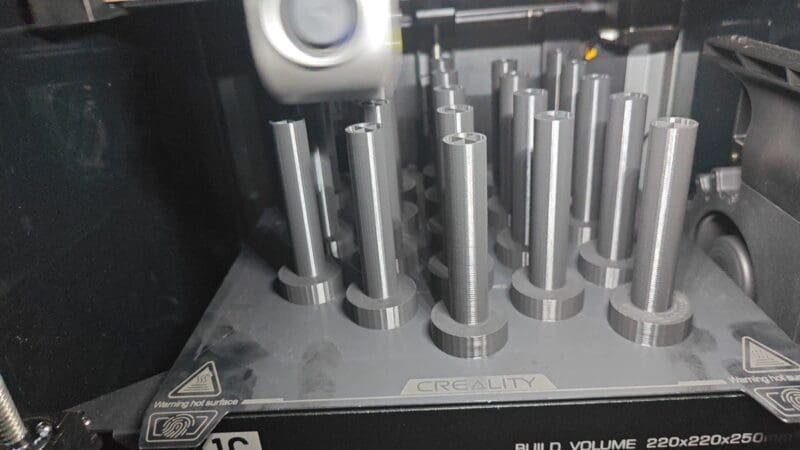How to Print Nylon on Ender 3?

Nylon filament is a popular material that both amateur and expert 3D printers use to make designs that last and look good. But an Ender 3 printer needs to be used in a different way to print with Nylon than with PLA or ABS. With this step-by-step guide, you’ll learn how to print nylon on Ender 3.
What is a Nylon Filament?
A synthetic thermoplastic material known as nylon filament has gained popularity among fans of 3D printing. One reason for this is that it is strong and durable, especially when it comes to making things that can be used in real life. People like nylon filaments because they can handle high temperatures, high stress, and high impacts. This makes them a good choice for making things that need to last a long time.
Preparation
The best way to get the best results when printing with Nylon thread on Ender 3 is to prepare properly. There are a few things to think about before you start the printing process.
1. Understanding the Ender 3 Printer
It’s important to learn how the machine works before you use it. You need to know how to set up the printer and know how to adjust it. This is especially important when using Nylon filament, which needs more exact settings for the best results. Before you start, you should know how to set the printer’s temperature, level the bed, set the speed, withdraw the print head, and set the nozzles. Your printing results will be much better if your 3D printer is set up well.
2. How to Choose the Right Nylon Filament
When picking a nylon filament, the diameter of the filament is key to a successful print. The majority of nylon filament strands have a 1.75mm diameter, however, you should make sure the spool you’re using is compatible with the Ender 3 extruder and can operate with it before using it. Second, not all nylon filaments are created equal. There are different kinds of nylon, such as Nylon 6 and Nylon 66, and each has its own qualities. Make sure you pick the type of Nylon that will work best for your job.
3. Check the settings on your Ender 3 printer
Before you can print with Nylon filament on an Ender 3, you need to make sure that your printer’s settings can handle it. Depending on the brand and size of the material, you should set the print temperature to between 235 and 250 degrees Celsius. Also, the bed temperature should be between 60 and 80 degrees Celsius, and the bed needs to be level for the plate to stick well. Setting the retraction is also important to keep the thread from getting tangled and wound around delicate parts.
How to Print Nylon on Ender 3?
You can start printing now that you’ve set up your machine and picked the right Nylon filament.
1. Load the Nylon filament into the Ender 3.
Moisture can cause Nylon filament to warp, so keep it dry and store it in a bag with a desiccant. Load the material through the extruder, which is how the Ender 3 is designed to work.
2. Get the Ender 3 Bed Plate ready.
To obtain optimal bed adhesion, prepare the bed plate by giving it a thorough cleaning. You might want to put glue or oil on the bed before you start printing to help the filament stick well.
3. Change the settings on the Ender 3 printer
Change the settings on your Ender 3 printer to fit the Nylon filament for the best results. Set the temperature to 245°C and the print speed to less than 40mm/s to get started. For the best bed stickiness, set the bed temperature to between 60 and 80 degrees Celsius.
4. Start the process of printing
Once you’ve set up your Ender 3 printer, you can start the printing process. To avoid any damage to your printer, make sure it is in good working order and that all parts are set up properly. Start printing at a slow speed to keep the filament from getting tangled up.
5. Finishing and processing after the fact
Post-processing and finishing are important steps that make sure the final result looks the way it should.
Getting rid of supports and bed sticking.
Once the print is finished, you will need to take it apart and get rid of any support material. This needs to be done carefully because it can affect how well your printed object turns out.
Making the Surface Smooth
Because nylon cools quickly, its surface tends to be rough. Some parts, though, need a smoother finish. By letting the material’s tensions loosen in warm water for a few hours, for instance, and then drying it under weight, you can smooth the print’s surface.
Painting and Coating
You can paint or varnish the print once it has been finished and smoothed out. Since paint doesn’t stick well to nylon, try adding a layer of primer before painting the final result. To get the best results, it would help to use a primer made for Nylon.
Conclusion
An excellent approach to maximize your printing capabilities on your Ender 3 3D printer is to print with nylon. Nylon filament is often used to print everyday things because it is strong and lasts a long time. To do it right, you need to be patient, accurate, and pay close attention to the details. To get the best result, make sure you have the right tools, materials, and settings. By doing these things, you’ll be able to make 3D models of the best quality. Never forget that 3D printing with Nylon on Ender 3 is not only useful but also fun!

FAQ
1. Can I print nylon with my Ender 3 printer?
Yes, you can use an Ender 3 to print with Nylon material. To get the best results, you need to make a few changes to the printer settings.
2. What type of Nylon material should I use for 3D printing on the Ender 3?
Nylon filament comes in a number of varieties, such as Nylon 6 and Nylon 66. Each kind of Nylon fiber has its own special qualities, so choose the kind that works best for your project.
3. How should I keep my nylon filament stored when it’s not in use?
Moisture can hurt the quality of nylon filament, so it’s best to put it in a sealed bag with a desiccant, like silica gel, to keep moisture from ruining it.
4. What temperature should I set my Ender 3 printer to when I want to print with Nylon filament?
If you want to print with Nylon fiber on an Ender 3 printer, the best temperature range is between 235 and 250 degrees Celsius. But this could be different based on the brand and size of the filament you use.
5. How can I stop my nylon filament from bending or warping while I’m printing?
When printing with Nylon filament, it’s important to keep the temperature of the print bed between 60 and 80 degrees Celsius to make sure the filament sticks well to the bed. Also, a well-calibrated printer and correctly set retraction settings can stop filament from twisting and bending in ways that aren’t wanted.
6. What is the right printing speed on the Ender 3 for printing with Nylon filament?
Most of the time, the best speed for printing with Nylon material on an Ender 3 is below 40mm/s. Slower printing speeds help the fiber stick better and keep it from getting tangled, which can happen at faster speeds.
7. How do I get rid of the support structures made from Nylon filament after printing?
It can be hard to get rid of support structures after printing, especially if you used Nylon. A sharp tool like pliers, tongs, or tweezers can help remove support structures without hurting the quality of the print.
8. Can I sand the surface of my Nylon 3D prints to make them smoother?
Yes, you can sand the surface of your printed Nylon items to make them smoother. You can do this by letting the item soak in warm water or gently sanding it with fine-grit sandpaper. But Nylon 3D prints might not be as smooth as PLA prints, so be patient and gentle when you smooth them out.
DISCLOSURE: THIS POST MAY CONTAIN AFFILIATE LINKS, MEANING I GET A COMMISSION IF you DECIDE TO MAKE A PURCHASE THROUGH MY LINKS, AT NO COST TO YOU. PLEASE READ MY DISCLOSURE FOR MORE INFO.



